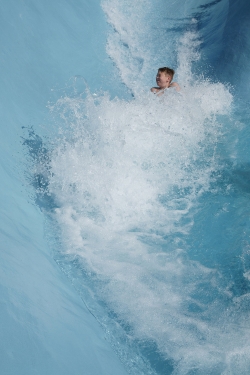Once your food is nice and chewed up, go ahead and swallow. We will follow it down a long dark tunnel that goes down, down, down. Above us is a light where you can see your tongue and teeth. What lies below? If we are going to find out what happens to your food, we need to venture forth! GULP!
There are ten inches of pink pipe between your mouth and your stomach. As we go through it, you will hear the rise and fall of your lungs breathing. There, to the left, you will hear the beat of your heart. Your
esophagus is the pipe that carries chewed up food from your mouth to your stomach. You can think of it as a tunnel through a mountain, the fastest way to get cars (or in this case, food) from one point to another. Try not to breathe and eat at the same time, or else there might be a bad accident.
There are two different kinds of traffic that come down this pipe: chewed up food and air. If you try to breathe while swallowing, your food or drink might end up down the wrong pipe! Not only does it hurt, it's also embarrassing. Your
windpipe is at the back of your throat and it leads the air you breathe to your lungs. There is a wall between these two pipes, but that does not mean food cannot go the wrong way.
Have you ever watched a snake eat? They don't chew up their food and then swallow it like a mammal would. Instead, they wrap their mouths around a dead rat and then slowly work it back with their throat and body. Once your food leaves your mouth, your esophagus does kind of the same thing.
Peristalsis is the pushing and squeezing that moves food down to the stomach and the rest of the digestive system. That's why you can drink or eat while lying down. It does not need to fall. The good news is that you do not have to think about it. Your body will just act like a snake and push the food where it needs to go.
Try sliding down a slide with bare legs. What happens? Your skin drags along the metal, slowing you down. Now try sliding down a water slide. Even if your bare legs are touching, you will rocket down as fast as gravity can carry you. Like water in a water slide, your body makes stuff to make your food move down faster and easier.
Mucus is the slimy liquid that helps your food move to your stomach without getting stuck. You know mucus -- when it comes out of your throat you call it snot. The only real difference between your esophagus and a water slide is that your food does not cry "Wheeeeee!" while it slides down.

Watch out, food coming through!
kallerna, CC BY-SA 3.0 , via Wikimedia Commons
Look up! We can't even see the light from the mouth anymore. We have come ten inches, pushed down your esophagus like the food of a snake. And we are still in one piece. A large cave lies ahead. It does not smell great, but we must go. We are scientists, after all.
References: "Science for Kids: The Digestive System." Ducksters. Technological Solutions, Inc. (TSI), June 2014.
<
http://www.ducksters.com/science/digestive_system.php>
Academic Kids. "Peristalsis." Academic Kids, 2010. <http://www.academickids.com/encyclopedia/index.php/Peristalsis>
Kid's Health. "Digestive System." Kids' Health, 2013. <http://kidshealth.org/PageManager.jsp?dn=KidsHealth&lic=1&ps=107&article_set=20538&cat_id=20090>